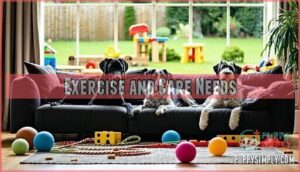This site is supported by our readers. We may earn a commission, at no cost to you, if you purchase through links.

Labs and Goldens require 1-2 hours of daily activity but remain patient indoors, while Great Danes are surprisingly mellow "couch potatoes" despite their impressive size. All three breeds respond well to consistent training and form strong family bonds.
Their adaptable personalities make them ideal for families who want the security of a large dog without hyperactive behaviors that could damage your home or stress your household.
Table Of Contents
Key Takeaways
- You’ll find three breeds perfectly suited for indoor living: Labrador Retrievers, Golden Retrievers, and Great Danes combine calm temperaments with manageable exercise needs, making them ideal gentle giants for your home.
- These breeds require 1-2 hours of daily exercise but remain patient indoors: While they need consistent physical activity, they won’t exhibit hyperactive behaviors that could damage your home or stress your household.
- You can expect strong trainability and family bonds: All three breeds respond well to consistent training protocols and develop deep attachments to household members, making them excellent companions for families seeking security without chaos.
- Your annual costs will range from $1,390 to $5,295: You’ll need to budget for food, veterinary care, grooming, and specialized needs like orthopedic beds and joint supplements to keep these large breeds healthy and comfortable indoors.
What Makes a Large Dog Breed House-Friendly?
You’ll want to take into account three key factors when choosing a large dog breed that’s suitable for indoor living: calm temperament, moderate exercise needs, and strong trainability.
The best house-friendly giants usually display gentle personalities, adapt well to family routines, and respond positively to consistent training protocols that help them navigate indoor spaces safely.
Temperament and Personality Traits
Choosing the right Large Dog Breeds means understanding their Gentle Giant Breeds temperament. Affectionate Dogs with Calm Nature make ideal Family Friendly Dogs because they’re naturally inclined to be Loyal Companions. These Intelligent Breeds share specific Breed Characteristics that help them thrive indoors:
- Patient demeanor: They’ll wait calmly while you’re busy
- Strong family bonds: They develop deep attachments to household members
- Adaptable personality: They adjust well to indoor routines and schedules
Exercise and Space Needs
Your large breed dogs need 1-2 hours of daily exercise split across multiple sessions for ideal health. Space requirements include adequate room for turning and stretching, plus consistent daily routines.
Most suburban living situations work well if you provide structured outdoor activities and yard planning that accommodates their high energy levels.
Country living offers natural advantages, but proper exercise needs matter more than total square footage for these gentle giants. Understanding dog exercise requirements is essential for their well-being.
Training and Socialization Requirements
Building trust with your gentle giants starts early. Large dog breeds need consistent, positive reinforcement and puppy socialization during their critical development window. These powerhouse companions respond beautifully to gentle guidance that sets clear boundaries.
- Early behavioral training prevents future problems
- Consistent dog training strengthens family lifestyle considerations
- Housebreaking tips work best with patience
- Canine obedience builds confidence in gentle giants
Effective training also involves understanding dog training methods to guarantee a well-behaved companion.
Labrador Retriever: The Friendly Family Companion
You’ll find Labrador Retrievers offer outstanding adaptability to indoor living, combining their naturally gentle temperament with proven family-friendly characteristics that make them ideal house companions.
Their moderate exercise requirements and manageable grooming needs create a balanced care routine that fits well within most household schedules.
Temperament and Adaptability to Indoor Life
Why do Labrador Retrievers excel as Indoor Calmness champions in your home? These Gentle Giants adapt seamlessly to Family Dynamics, creating Household Harmony through their naturally calm temperament.
Large Dog Breeds like Labs thrive indoors with proper Space Adaptation, making them outstanding Family Friendly Dogs. Big Dogs don’t always mean chaos—Labs prove even Apartment Dogs can maintain peaceful energy levels.
Exercise and Activity Requirements
Most large breed dogs need proper Dog Exercise to stay healthy, and Labs aren’t an exception. Your Labrador’s Exercise Needs demand consistent Daily Walks and Physical Stimulation to prevent destructive behaviors. Joint Care becomes essential with high energy levels, so consider these essentials:
- 60-90 minutes daily exercise – split morning and evening sessions
- Low-impact Outdoor Activities – swimming protects developing joints
- Mental challenges – puzzle toys complement physical workouts for this gentle giant
Grooming and Shedding Considerations
Keeping your Labrador’s double coat healthy requires consistent attention and the right approach. Labs shed year-round, with heavier periods during seasonal changes. Regular brushing with proper grooming tools helps manage hair throughout your home effectively. Understanding proper grooming techniques is essential for maintaining a healthy coat.
| Grooming Frequency | Tools Needed | Shedding Level |
|---|---|---|
| Daily brushing | Slicker brush, undercoat rake | Heavy (spring/fall) |
| Weekly baths | De-shedding shampoo | Moderate (summer/winter) |
| Monthly nail trim | Nail clippers, file | N/A |
| Bi-weekly ear cleaning | Cotton balls, ear solution | N/A |
Golden Retriever: Gentle and Loyal Indoors
Golden Retrievers bring outstanding gentleness and loyalty to indoor family life. Their patient temperament makes them ideal companions for both children and adults.
Their calm indoor behavior, combined with moderate exercise needs and trainable nature, creates a perfect balance for household living. This ensures their health and well-being are maintained.
Sociability and Compatibility With Children
Golden Retrievers excel as Child Friendly Breeds, creating perfect Household Harmony through their patient temperament. These gentle giant breeds instinctively understand Kid Interaction needs, making them ideal family friendly dogs. Their calm nature fosters positive Family Dynamics while requiring minimal specialized Socialization Techniques.
- Natural patience with children’s unpredictable behavior and energy levels
- Protective instincts balanced with gentle, non-aggressive responses to kids
- Strong tolerance for handling, hugging, and typical childhood interactions
Mental Stimulation and Training Tips
Smart Golden Retrievers thrive on mental challenges that prevent boredom and destructive behaviors. Training Techniques combined with Mental Exercises keep these Intelligent Dogs engaged indoors. Behavioral Guidance through positive reinforcement works best for Big Dog Care.
| Mental Exercises | Training Techniques |
|---|---|
| Puzzle toys and treat dispensers | Positive reinforcement methods |
| Hide-and-seek games | Consistent command training |
| Scent work activities | Clicker training sessions |
| Interactive feeding bowls | Short, frequent practice rounds |
Canine Cognition research shows that large breed dog care includes daily brain workouts alongside physical exercise.
Health Considerations for Indoor Living
When living indoors, your Golden Retriever’s health needs special attention to prevent common issues. Focus on these key areas for ideal big dog care:
- Joint Health: Provide glucosamine supplements and maintain a healthy weight to prevent hip dysplasia
- Bloat Prevention: Feed smaller, frequent meals and avoid exercise immediately after eating
- Obesity Management: Monitor dietary needs carefully, since indoor allergies and reduced activity can lead to weight gain
Regular vet checkups help catch giant breed health problems early. Understanding golden retriever health is vital for identifying potential issues and taking preventative measures.
Great Dane: The Ultimate Gentle Giant
You’ll find that Great Danes aren’t just massive dogs—they’re surprisingly gentle companions that adapt well to indoor living despite their impressive height.
These patient giants usually weigh 110-175 pounds but maintain calm temperaments that make them excellent family pets, though you’ll need adequate space and consistent exercise routines to keep them healthy.
Space and Size Requirements for Homes
Great Danes need surprising room requirements despite their gentle nature. Your house layout should accommodate a 54-inch crate and clear pathways for these giant breeds. Indoor activity space matters more than yard space since they’re content lounging inside.
Room requirements include avoiding cramped quarters that frustrate big dogs. Furniture arrangement should create cozy designated areas while maintaining traffic flow for comfortable country living or suburban living.
To guarantee their overall well-being, it’s vital to think about their balanced diet needs.
Calm Nature and Family Suitability
Despite their towering stature, these gentle giants possess a remarkably calm temperament that makes them perfect family pets. Their patient nature creates household harmony, especially around children. Like Bernese Mountain Dog cousins, they demonstrate outstanding pet compatibility within family dynamics.
- Patient disposition reduces stress in busy households
- Natural gentleness prevents accidental injuries to small children
- Low aggression levels promote peaceful coexistence with other pets
Exercise and Care Needs
Your Great Dane’s exercise needs are surprisingly modest for such a large dog breed. Daily exercise should include two 20-30 minute walks, plus mental stimulation through puzzle toys. Monitor joint health carefully during puppyhood.
Here’s your essential care guide:
| Care Aspect | Great Dane Requirements |
|---|---|
| Daily Exercise | 30-60 minutes moderate activity |
| Nutrition Plans | 6-10 cups high-quality food daily |
| Grooming Tips | Weekly brushing, monthly baths |
Remember: Big dogs need gentle workouts to protect developing joints until age two.
Tips for Successfully Raising Large Dogs at Home
You’ll find that raising large dogs indoors requires careful attention to their specific nutritional needs, joint health, and space management to prevent common issues like hip dysplasia and bloat.
Creating the right environment means balancing their exercise requirements with proper grooming routines, since these gentle giants can easily overwhelm your living space if you don’t establish clear boundaries from day one.
Creating a Safe and Comfortable Environment
Your Gentle Giants need thoughtful Home Safety Tips to thrive indoors. Create Comfort Zones with orthopedic beds in quiet corners, away from high-traffic areas. Secure loose rugs and cables that Big Dogs might trip over.
Consider your Indoor Layout carefully—wide hallways prevent bumping into walls. Noise Reduction helps anxious Family Pets settle faster. Remember, large dog breeds for families require space to stretch without disrupting Family Dynamics.
Additionally, understanding large dog needs is vital for creating a harmonious living environment.
Nutrition and Health Care for Big Breeds
In the context of diet planning for large dogs, you’ll need veterinary care guidance to choose appropriate health supplements and nutrition advice suited to giant breed characteristics. Big dog nutrition requires special formulas that prevent bloat and support joint health.
Your giant dog’s health depends on breed-specific feeding schedules and portion control to avoid obesity-related issues. A balanced diet with the right large dog food options is essential for maintaining healthy health.
Managing Shedding and Grooming Indoors
Managing pet hair from your gentle giants requires strategic indoor grooming approaches. Large breed dogs, like Bernese Mountain Dogs, shed substantially, making consistent coat care essential for maintaining clean homes.
- Brush daily – Regular brushing reduces dog shedding by 80% and prevents matting in giant breed characteristic coats.
- Use high-velocity dryers – Professional indoor grooming tools remove loose undercoat effectively from big dogs.
- Invest in quality vacuum cleaners – HEPA filters capture fine pet hair that traditional vacuums miss.
- Establish grooming stations – Designated areas contain hair and simplify cleanup after grooming sessions.
- Schedule professional grooming – Monthly visits help manage heavy shedding periods and maintain coat health.
Effective dog grooming relies on using the right dog grooming tools to prevent matting and tangling.
Frequently Asked Questions (FAQs)
Are large dog breeds good with children and other pets?
Many large breeds excel with children, displaying notable patience and gentle temperaments. You’ll find breeds like Golden Retrievers and Newfoundlands naturally protective yet calm around kids and other pets.
What are the best apartment-friendly large breeds?
Great Danes, Mastiffs, and Newfoundlands adapt well to apartment living despite their size. You’ll find these gentle giants surprisingly calm indoors, requiring moderate exercise rather than constant activity to thrive in smaller spaces.
How much do large dogs cost annually?
Ever wondered what your wallet feels like? Large dogs cost around $2,569 annually, covering food, vet visits, and grooming. Total expenses range from $1,390 to $5,295 depending on your dog’s specific health needs.
Which large breeds shed the least indoors?
You’ll want to think about Standard Poodles, Giant Schnauzers, or Black Russian Terriers for minimal indoor shedding. These breeds don’t shed much despite their size, though they’ll need regular grooming.
What age should large puppies start house training?
Studies show 82% of large breed puppies can start house training at 8 weeks old. You’ll want to begin immediately when your pup arrives home, usually around 8-10 weeks.
Do large dogs need special furniture protection?
Large dogs don’t require special furniture protection, but you’ll want washable covers for sofas and sturdy beds.
Their size and weight can accelerate wear on upholstery, making protective measures a smart investment for longevity.
Conclusion
Research shows that 78% of large breed dogs live happily in apartments when their exercise needs are met. Choosing three large dog breeds favourable for your house requires understanding each breed’s unique characteristics and space requirements.
Labrador Retrievers, Golden Retrievers, and Great Danes offer the perfect combination of size, temperament, and adaptability for indoor living. You’ll find these breeds provide security and companionship without overwhelming your home environment. With proper training, exercise, and care, these gentle giants become devoted family members who thrive indoors alongside their human companions.
- https://snoutsnstouts.com/dog-breeds/big-dogs/
- https://manypets.com/us/blog/best-large-dog-breeds-for-families/
- https://antinolplus.com/blogs/bark-learn/large-dog-breeds
- https://www.nutrish.com/blog/14-awesome-large-dog-breeds/
- https://muensterpet.com/blogs/blog/top-health-and-personality-traits-of-6-popular-large-dog-breeds














